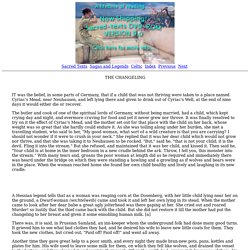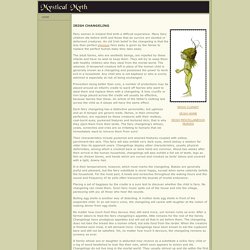

Bloodletting. The Fairy Mythology: Germany: The Changeling. Sacred Texts Sagas and Legends Celtic Index Previous Next IT was the belief, in some parts of Germany, that if a child that was not thriving were taken to a place named Cyriac's Mead, near Neuhausen, and left lying there and given to drink out of Cyriac's Well, at the end of nine days it would either die or recover.

The butler and cook of one of the spiritual lords of Germany, without being married, had a child, which kept crying day and night, and evermore craving for food and yet it never grew nor throve. It was finally resolved to try on it the effect of Cyriac's Mead, and the mother set out for that place with the child on her back, whose weight was so great that she hardly could endure it.
Changeling Legends from the British Isles. Edited by D.

L. Ashliman, University of Pittsburgh © 1998-2002 Return to: Table of Contents. The Complete History & Progression of Bloodletting. Let's say you just can't seem to wake up in the morning and you remain tired throughout the day.

You also experience aching joints and abdominal pain. Naturally, you visit your doctor, expecting to receive the typical lecture about eating right and exercising. Maybe they will write you a prescription to relieve your symptoms. But instead, your doctor asks a remarkable question that leaves you absolutely dumbfounded. Changelings: Mythology and Folklore. Changeling A non-human child that has been left in the place of a stolen human child.

The old superstition was that young children could be abducted by fairies before they were baptized, and in those days children were watched carefully until that ceremony was over. It was believed that the fairies exchanged their own frail children for the healthy children of human women. The children left behind, the changelings, were always malformed, stunted, or mentally ill but sometimes they were wise beyond their years and spoke of things beyond the understanding of children. A mother who suspected her child of being a changeling could trick him by performing a remarkable task such as pretending to prepare an entire meal in an empty eggshell. Acorns before the oak I knew; An egg before a hen; Never one hen's egg-shell stew Enough for harvest men! There are many such sayings from many places, another version goes: Long have I lived and much have I seen.
Also known as plentyn-newid or change-child. A Brief History of Bloodletting - History in the Headlines. The ancient practice of bloodletting might offer cardiovascular benefits to obese people with metabolic syndrome, a new study published today in the journal BMC Medicine suggests.

As the medical community contemplates its revival, explore this long-abandoned procedure’s age-old history, from its early roots to its use on figures such as George Washington and Marie-Antoinette. Several thousand years ago, whether you were an Egyptian with migraines or a feverish Greek, chances are your doctor would try one first-line treatment before all others: bloodletting.
He or she would open a vein with a lancet or sharpened piece of wood, causing blood to flow out and into a waiting receptacle. If you got lucky, leeches might perform the gruesome task in place of crude instruments. Considered one of medicine’s oldest practices, bloodletting is thought to have originated in ancient Egypt.
America’s first president was less fortunate than France’s most infamous queen. Bloodletting: an early treatment used by barbers, surgeons. Bloodletting was used for hundreds of years to help cure illness and restore health, and its popularity thrived in the 19th century.

Even though its effectiveness was routinely questioned, the procedure was used for cardiac problems into the 1920s. Bloodletting has been employed since ancient times as a method to keep the body’s so-called four humors in balance. By the second millennium, the belief in the four humors began to decline, but bloodletting remained popular. Because surgery was still a crude practice, many physicians avoided it. Instead, people turned to the church for medical help. This series of events would lead to the rise of the barber-surgeon. Barbers performed a wide variety of functions at that time. Already prepared with the tools needed to perform venesection, barbers developed a thriving bloodletting practice from 1100 to 1500.
As more was learned about surgery, a transition began from barbers to more experienced physicians performing bloodletting. Mystical Mythology from around the world. Their characteristics include puckered and wizened features coupled with yellow, parchment-like skin.

This fairy will also exhibit very dark eyes, which betray a wisdom far older than its apparent years. Changelings display other characteristics, usually physical deformities, among which a crooked back or lame hand are common. About two weeks after their arrival in the human household, changelings will also exhibit a full set of teeth, legs as thin as chicken bones, and hands which are curved and crooked as birds' talons and covered with a light, downy hair.
It is their temperament, however, which most marks the changeling. Babies are generally joyful and pleasant, but the fairy substitute is never happy, except when some calamity befalls the household. Placing a set of bagpipes by the cradle is a sure test to discover whether the child is fairy. Boiling egg shells is another way of detecting. No matter how much food they devour, they still want more, yet remain runty as ever. The Benefits of Giving Blood.